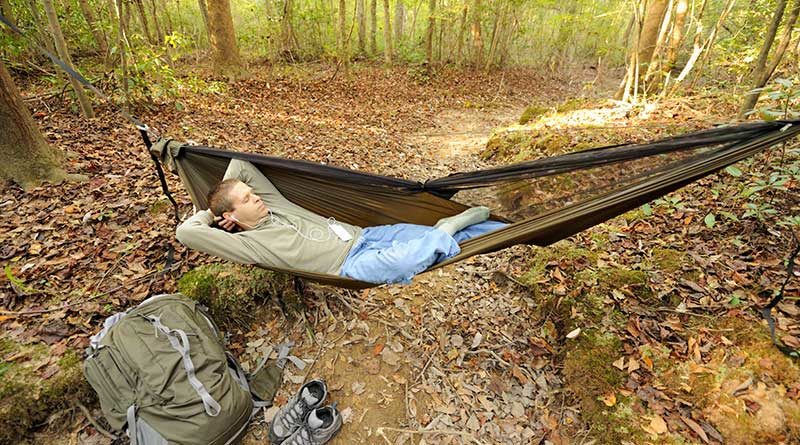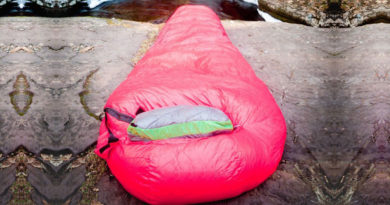Can you Hammock Camp without an Underquilt?
Most people love hammock camping because of its minimalist approach. Hammock camping in the summer is pleasant and fun but it can be hard at night because nights are chilly. Hammocks lack the bottom insulation of a conventional camp setup. Hammock campers are pretty familiar with what’s known as a “freezing butt”. It’s when you wake up in the night shivering from the cold and you can’t feel your butt because of the cold. Being suspended over the cold ground doesn’t help as it is the cold wind that takes away the heat from your body.
As the temperature drops, the amount of gear you need to keep yourself warm also goes up. You need more gear for insulation so that you can keep yourself warm. That is where a hammock underquilt comes in.
A hammock underquilt is an insulated quilt that hangs snugly below a hammock to prevent heat loss. They are the best option to keep you warm during cold nights. But underquilts are very expensive. Not many people can afford them. They are also heavy and bulky. Some hammock campers who like to pack ultralight look for alternatives.
Finding alternatives to hammock underquilts and making them work is tricky. Does that mean you should give up on hammock camping or accept the suffering? Certainly not. There are viable alternatives available.
Alternatives to Underquilts
If you don’t have an underquilt, you can use the following alternatives to keep yourself warm. But do keep in mind that these options are not as comfortable as an underquilt. Underquilts are expensive because they are the best option.
These alternatives are cheap and you would probably need two or more alternatives together for enough warmth as an underquilt.
Sleeping Pads
Sleeping pads are the best alternative to underquilts. They cost a lot less, they weigh a lot less, and they are straightforward to use. Simply place the sleeping pad under your sleeping bag before settling in for the night.
Pads can be either foam pads or air pads. Foam pads are cheaper and more durable than air pads. But foam pads are also heavier and bulkier than air pads. A lightweight alternative to foam pads is closed-cell foam pads. They are lightweight, affordable, versatile, durable, and work the same way as normal pads. But closed-cell foam pads are less comfortable and don’t pack tight.
Air pads, on the other hand, are a better option. They are extremely light and pack tight expensive. However, the comfort they provide is unmatched. Sleeping in a hammock is already more comfortable than sleeping on the ground which negates the comfort factor of air pads.
But there are a few drawbacks to using sleeping pads. Many people find it difficult to stay on top of their pads. Pads tend to shift around underneath. An easy solution to this is to put the pad inside your sleeping bag. No matter how much you turn and move, the pad will stay under you. Some hammocks have double layers. You can put the pad between the layers to stay insulated. But you would have to buy a hammock with double layers then.
Another problem with pads is that they only insulate the underside of your body. Hammocks compress the pad near the shoulders making the shoulders cold. Some pads are designed with extra flaps on the sides to overcome this problem. You can also add the flaps yourself. Another easy solution is to put some clothes under your shoulder to keep them warm.
You can also get hammock sleeping pads. They are tailored for hammock use and provide much better insulation in hammocks. Do keep in mind that pads are vapor barriers and may cause condensation at night.
Mylar Blanket
Mylar is the commercial name of biaxially-oriented polyethylene terephthalate (BoPET). It is plastic with aluminum or some other metal in it. They were invented by DuPont in 1950 and were used by NASA in their space missions, hence, also known as space blankets.
These blankets have a metallic film that acts as a reflective surface. They work by reflecting the heat towards your body. It is an effective way of heat retention. They are also known as survival blankets because of their ability to prevent hypothermia.
These blankets are lightweight and can be packed as a backup for an emergency. They are inexpensive, easy to find, and easy to use. Just wrap the blanket around yourself or your sleeping bag for insulation. They are waterproof and windproof making them an excellent hammock accessory.
Mylar blankets also prevent heat loss through evaporation. That is why marathon runners use Mylar wraps after a run because the human body loses 80% of body heat due to evaporation through sweating.
Layering your Clothes
Another easy solution is layering your clothes. Layering is always a good idea when camping in winter. It is an effective way of regulating body temperature. For comfort and efficiency, you can keep extra clothes inside your hammock. You can wear the clothes as soon as you get cold. That way you won’t have to get out of the hammock in the cold.
Pass your Hammock through your Sleeping Bag
Sleeping bags usually have two zippers – one to open the bag and the other at the foot of the sleeping bag. If your sleeping bag is big enough, you can open the foot zipper and pass the hammock through there. You can wrap your hammock completely in your sleeping bag like so.
The tricky part is to fasten the hood of the bag to the hammock tightly so that it doesn’t allow cold air in. But keep in mind that this setup is difficult and may require the assistance of another person. This setup also makes it difficult to get in and out of the hammock.
Avoid the Wind
This is not exactly an alternative to an underquilt because when it is cold, it’s cold. This one is more of a helpful tip. When hammock camping, you should always consider the wind direction. You should look for natural windbreaks like trees, rock formations, and hills.
It is always better to camp surrounded by trees than in an open area. More wind would take away your body heat. You would need more insulation to counter that. It is better that you avoid the wind and camp in a place that is relatively warmer.
Staying warm without an underquilt
If you are shy of purchasing an underquilt or any other insulation thing, you can still keep yourself warm in a hammock. Just get a 3 mil thick 55-gallon drum liner. Go around on the forest floor and collect up leaves and fill this bag to the brim. Make sure you keep this thing as plush and as fluffy as you can so that it can give you good insulation. Once you have your drum liner filled, it’s just a matter of sealing up the bag. You can tie it with a bow or however you like.
Now, lay this drum liner full of debris and just try to disperse all that debris out evenly through the bag. Slide it under your hammock and estimate roughly where your core is going to rest in the hammock. You want this thing to be about centered with the hammock.
Before having that underquilt, this is the method that I would use and I have found that it is very warm and comfortable. It’s a great way to use your hammock and it keeps you warm in even cold weather.
Final Thoughts
An underquilt would make your life much easier when hammock camping in cold weather. But being expensive and heavy, many people prefer not to take them. But that is not the end of hammock camping. If you know how to insulate yourself properly, then you can do well without an underquilt.




